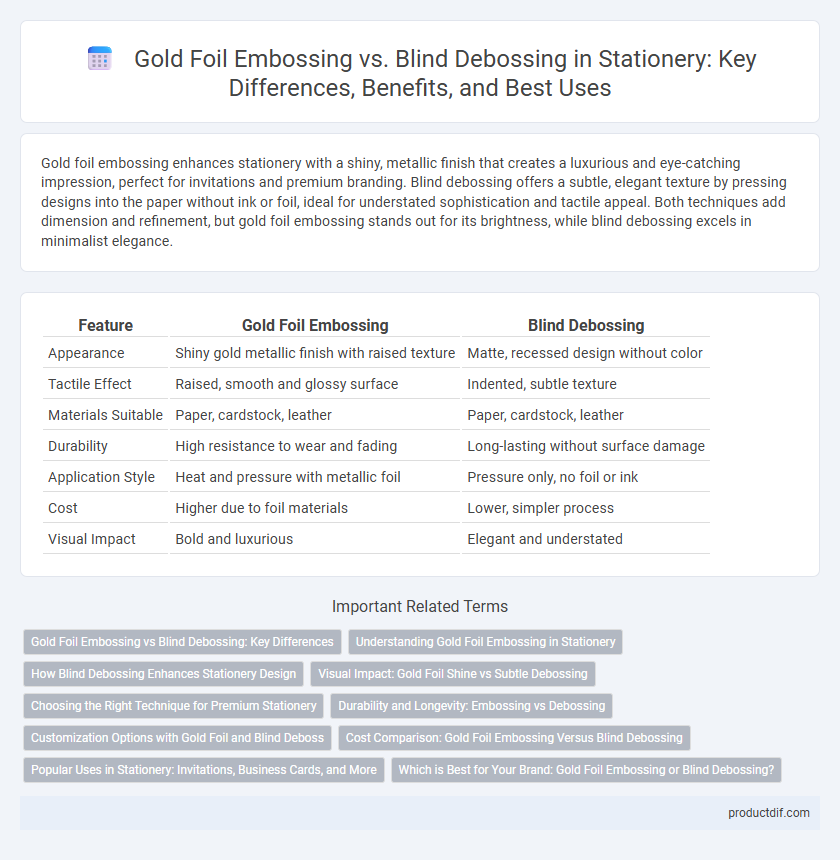Gold foil embossing enhances stationery with a shiny, metallic finish that creates a luxurious and eye-catching impression, perfect for invitations and premium branding. Blind debossing offers a subtle, elegant texture by pressing designs into the paper without ink or foil, ideal for understated sophistication and tactile appeal. Both techniques add dimension and refinement, but gold foil embossing stands out for its brightness, while blind debossing excels in minimalist elegance.
Table of Comparison
| Feature | Gold Foil Embossing | Blind Debossing |
|---|---|---|
| Appearance | Shiny gold metallic finish with raised texture | Matte, recessed design without color |
| Tactile Effect | Raised, smooth and glossy surface | Indented, subtle texture |
| Materials Suitable | Paper, cardstock, leather | Paper, cardstock, leather |
| Durability | High resistance to wear and fading | Long-lasting without surface damage |
| Application Style | Heat and pressure with metallic foil | Pressure only, no foil or ink |
| Cost | Higher due to foil materials | Lower, simpler process |
| Visual Impact | Bold and luxurious | Elegant and understated |
Gold Foil Embossing vs Blind Debossing: Key Differences
Gold Foil Embossing applies a metallic gold layer that creates a shiny, raised texture, enhancing visual appeal and luxury perception. Blind Debossing produces a subtle, indented design without color, relying on light and shadow to highlight the impression for a more understated, tactile effect. Gold Foil Embossing is ideal for premium stationery requiring vibrant, eye-catching detail, while Blind Debossing suits minimalist designs emphasizing texture over color.
Understanding Gold Foil Embossing in Stationery
Gold Foil Embossing in stationery involves applying a thin layer of metallic gold foil onto paper using heat and pressure, creating a raised, reflective design that enhances visual appeal and adds a luxurious touch. This technique improves both the texture and depth of invitations, business cards, and other paper products, making them stand out with elegant, eye-catching details. Unlike blind debossing, which only creates a recessed impression without color, gold foil embossing combines texture with shimmering gold finish for a sophisticated, premium look.
How Blind Debossing Enhances Stationery Design
Blind debossing enhances stationery design by creating subtle, elegant impressions without the use of ink or foil, resulting in a sophisticated, tactile texture that elevates the overall aesthetic. This technique adds depth and dimension, highlighting logos, monograms, or patterns through the play of light and shadow on the paper surface. Blind debossing is ideal for minimalist designs, luxurious invitations, and corporate stationery seeking a refined, understated look.
Visual Impact: Gold Foil Shine vs Subtle Debossing
Gold foil embossing creates a striking visual impact with its reflective shine and luxurious gold finish that immediately draws attention on stationery designs. In contrast, blind debossing offers a subtle, elegant impression by pressing shapes or text into the material without ink or foil, enhancing texture and sophistication without color. Choosing between the two depends on whether a bold, eye-catching highlight or a refined, understated effect suits the branding and purpose of the stationery.
Choosing the Right Technique for Premium Stationery
Gold foil embossing creates a luxurious, raised metallic effect that enhances visual appeal and tactile experience, making it ideal for prestigious invitations and branding. Blind debossing offers a subtle, elegant indentation without color, perfect for understated sophistication and textured designs. Selecting the right technique depends on the desired impact: opt for gold foil embossing to highlight key elements with shine or blind debossing for refined, minimalist aesthetics in premium stationery.
Durability and Longevity: Embossing vs Debossing
Gold foil embossing offers enhanced durability due to the metallic foil layer that resists fading and wear over time, making it ideal for long-lasting stationery designs. Blind debossing, while elegant and subtle, often shows wear more quickly since it relies on embossed impressions without protective coatings. For projects demanding longevity and frequent handling, gold foil embossing provides superior resilience compared to blind debossing.
Customization Options with Gold Foil and Blind Deboss
Gold foil embossing offers vibrant customization options by adding a metallic gold layer that enhances logos and text with shimmer and depth, ideal for luxury stationery. Blind debossing provides subtle, elegant customization by creating impressions without ink or foil, perfect for minimalistic designs that rely on texture and shadow. Both techniques allow precise customization but differ in visual impact, with gold foil emphasizing brightness and blind deboss highlighting tactile embossment.
Cost Comparison: Gold Foil Embossing Versus Blind Debossing
Gold foil embossing typically incurs higher costs than blind debossing due to the added expense of metallic foil materials and specialized heat-press equipment. Blind debossing requires less material and simpler tooling, resulting in more affordable production costs, especially for bulk orders. Businesses should weigh these cost differences against the desired visual impact and brand perception when selecting between gold foil embossing and blind debossing for stationery.
Popular Uses in Stationery: Invitations, Business Cards, and More
Gold foil embossing is widely favored in stationery for invitations and business cards due to its shiny, luxurious finish that enhances brand prestige and event elegance. Blind debossing offers a subtle, sophisticated texture popular in minimalistic designs, often used for embossing logos on high-end letterheads and wedding invitations without color contrast. Both techniques elevate stationery by adding tactile and visual interest, catering to different aesthetic preferences and occasions.
Which is Best for Your Brand: Gold Foil Embossing or Blind Debossing?
Gold foil embossing creates a striking, reflective surface that enhances brand visibility and conveys luxury, ideal for premium stationery and high-end packaging. Blind debossing offers a subtle, tactile impression without color, perfect for minimalist designs seeking elegance and understated sophistication. Choosing between gold foil embossing and blind debossing depends on whether your brand aims for bold visual impact or refined texture to communicate its identity.
Gold Foil Embossing vs Blind Debossing Infographic

 productdif.com
productdif.com